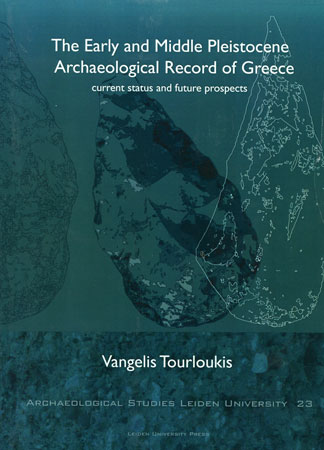The Early and Middle Pleistocene Archaeological Record of Greece: Current Status and Future Prospects
Vangelis Tourloukis

Πόλη: Leiden
Έτος: 2010
Εκδότης: Leiden University Press
Σειρά: Archaeological Studies Leiden University 23
Περιγραφή: Μαλακό εξώφυλλο, 261 σ., ασπρόμαυρες εικόνες στο κείμενο, 28x20,8 εκ.
Περίληψη (στα Αγγλικά)
Although the Greek Peninsula lies within a core area of early hominin movements between Africa and Europe but also within Eurasia itself, the Lower Palaeolithic record of Greece remains as yet extremely poor. Choosing the scanty Greek record as a case-study, Tourloukis elaborates on a hitherto largely overlooked subject in the Eurasian Early-Middle Pleistocene archaeology: the role of geomorphic processes in biasing archaeological distribution patterns of early human presence. This study identifies the current status of the record, explains this status from a geoarchaeological and geomorphological perspective, and prospects its future enrichment. The analysis is carried out on a landscape-scale and it assesses preservation potential in conjunction with archaeological visibility. Finally a conceptual model emerges that can assist in interpreting and/or predicting early Palaeolithic site locations in tectonically active settings, such as those of the Mediterranean Basin.
Περιεχόμενα
1. Introduction [11]
1.1 Key research questions [11]
1.2 Scope, objectives and structure of the book [12]
2. Lower Palaeolithic archaeology and the peopling of Europe [15]
2.1 The Lower Palaeolithic period: an introduction [15]
2.2 Early dispersals and the first occupation of Europe [19]
3. Lower Palaeolithic records of the circum-Mediterranean area [23]
3.1 Introduction [23]
3.2 The Italian Peninsula [24]
3.3 The Iberian Peninsula [28]
3.4 North Africa [32]
3.5 The Levant [35]
3.6 Balkans and Turkey [38]
3.7 Conclusions and discussion [42]
4. The Lower Palaeolithic record of Greece [45]
4.1 Introduction (with a short reference to the Middle Palaeolithic) [45]
4.2 The palaeoanthropological record [50]
4.2.1 Petralona [50]
4.2.2 Apidima [52]
4.3 North Greece [53]
4.3.1 Thrace [53]
4.3.2 Macedonia [54]
4.4 Ionian Islands [56]
4.4.1 Nea Skala, Kephallonia [57]
4.4.2 Korissia, Kerkyra [58]
4.5 Epirus [58]
4.5.1 Introduction [58]
4.5.2 Geology, geomorphology and geoarchaeology of Epirus [59]
4.5.3 Previous research and interpretations [62]
4.5.4 Revisiting Kokkinopilos: fieldwork results [67]
4.5.5 Conclusions and discussion [76]
4.5.6 Alonaki [82]
4.6 Thessaly [87]
4.6.1 Introduction [87]
4.6.2 Geology and geomorphology of Thessaly [88]
4.6.3 Previous research and interpretations [89]
4.6.4 Revisiting Thessaly: fieldwork results [93]
4.6.5 Conclusions and discussion [106]
4.7 Peloponnesus [109]
4.7.1 Peiros river valley [109]
4.7.2 Megalopolis basin [110]
5. Pleistocene deposits and the absence of stratified Lower Palaeolithic evidence: two case-studies [115]
5.1 Introduction [115]
5.2 Aliakmon Survey Project [115]
5.3 Zakynthos Archaeology Project [120]
6. Quaternary landscape evolution and the preservation of Pleistocene sediments [127]
6.1 Introduction [127]
6.2 Climatic controls [128]
6.2.1 The climate of Greece [128]
6.2.2 Climate, weathering and surface processes [130]
6.2.3 Quaternary climate changes in Greece [132]
6.2.4 Geomorphic responses to Quaternary climate changes, fluvial erosion and slope processes [142]
6.2.5 Discussion [146]
6.3 Tectonic controls [147]
6.3.1 Introduction [147]
6.3.2 Overview of the main tectonic phases [148]
6.3.3 Geodynamic interpretation and geomorphological consequences [151]
6.3.4 Discussion [159]
6.4 Sea-level changes [160]
6.4.1 Introduction [160]
6.4.2 Sea-level changes: contributing factors and complicating perplexities [160]
6.4.3 Quaternary sea-levels and palaeogeography of Greece [162]
6.4.4 Prospects of underwater and terrestrial investigations of the Aegean Lower Palaeolithic record [168]
6.5 Surface processes [173]
6.5.1 Introduction [173]
6.5.2 Erosion measurement and modeling [174]
6.5.3 Vegetation [176]
6.5.4 Lithology [176]
6.5.5 Soils [177]
6.5.6 Land use [178]
6.5.7 Topography [180]
6.5.8 Geomorphological opportunities for the preservation of Lower Palaeolithic material: a working hypothesis for the Greek landscapes and the role of topography [181]
6.5.9 Discussion and conclusions [189]
6.6 Conclusions [191]
7. Synthesis [197]
7.1 Introduction [197]
7.2 Identifying the current status of the Greek Lower Palaeolithic [197]
7.3 Explaining the current status of the Greek Lower Palaeolithic [201]
7.4 Prospecting the future of Lower Palaeolithic investigations in Greece [207]
7.5 Suggested research subjects for future examinations [211]
Epilogue [215]
References [219]
English Summary [249]
Dutch Summary [251]
List of Figures [253]
List of Tables and Appendices [255]
Abbreviations and Notes [257]
Acknowledgements [259]
Curriculum Vitae [261]

Σχόλια
Παρακαλούμε τα σχόλιά σας να είναι στα Ελληνικά (πάντα με ελληνικούς χαρακτήρες) ή στα Αγγλικά. Αποφύγετε τα κεφαλαία γράμματα. Ο Αιγεύς διατηρεί το δικαίωμα να διαγράφει εκτός θέματος, προσβλητικά, ανώνυμα σχόλια ή κείμενα σε greeklish.